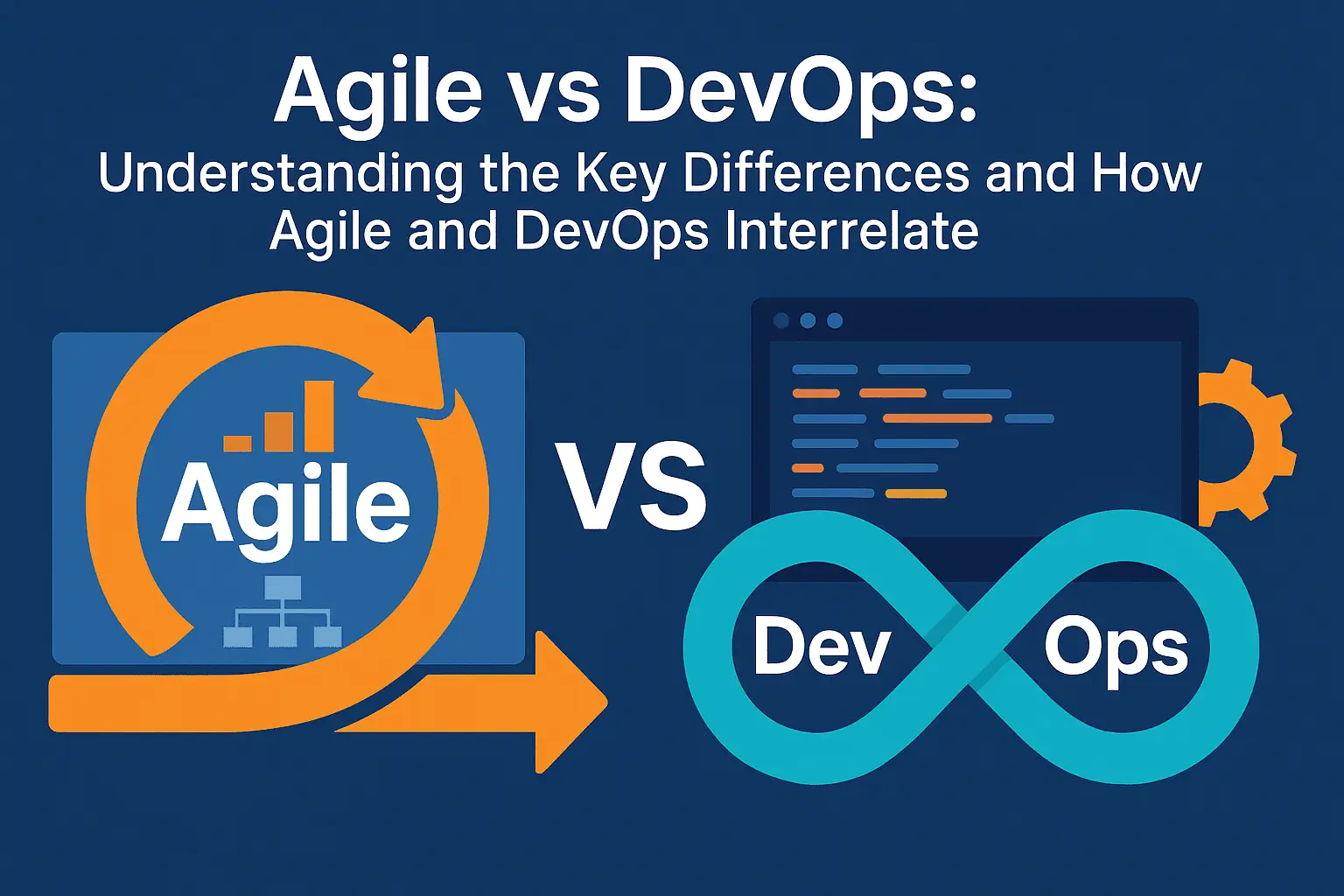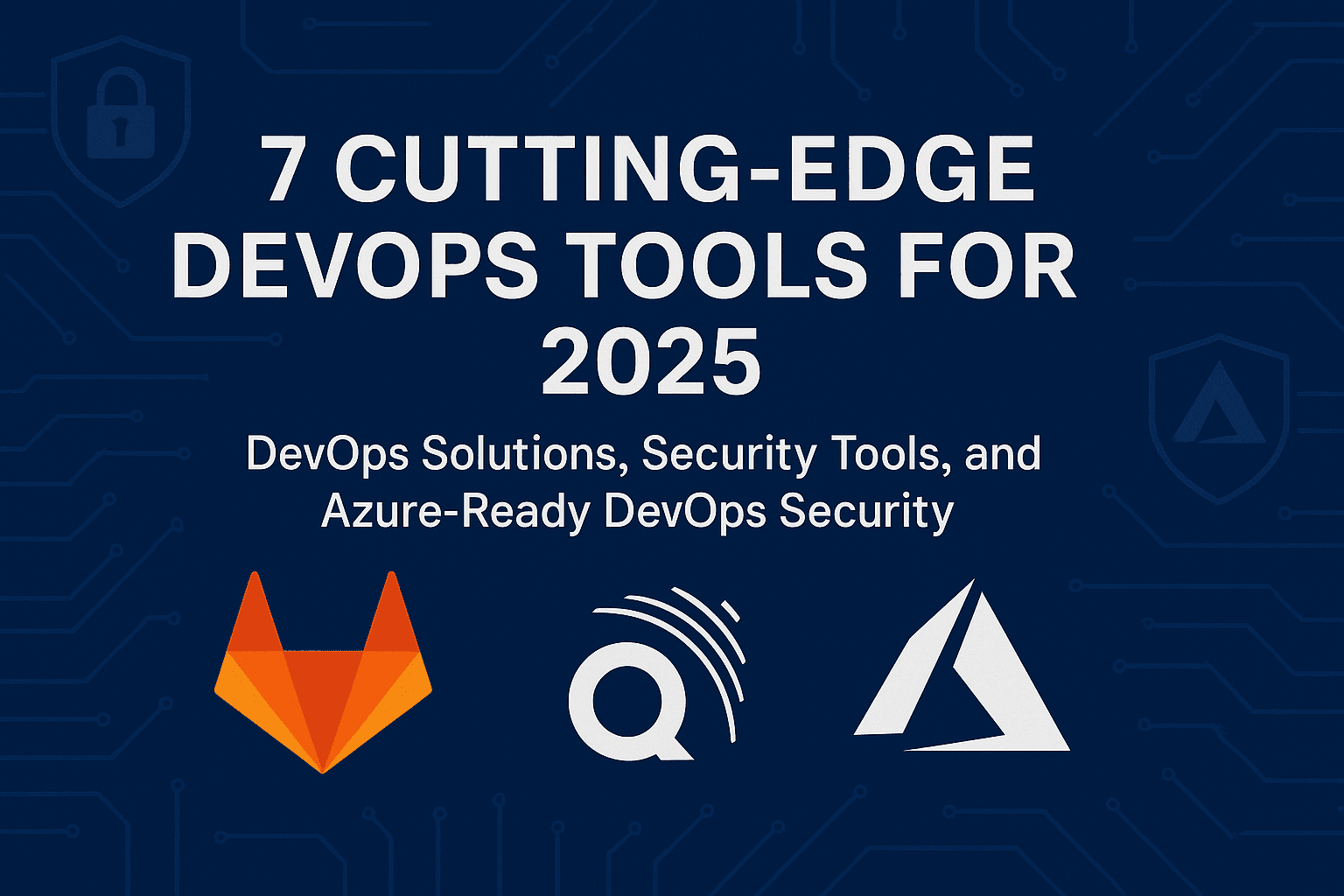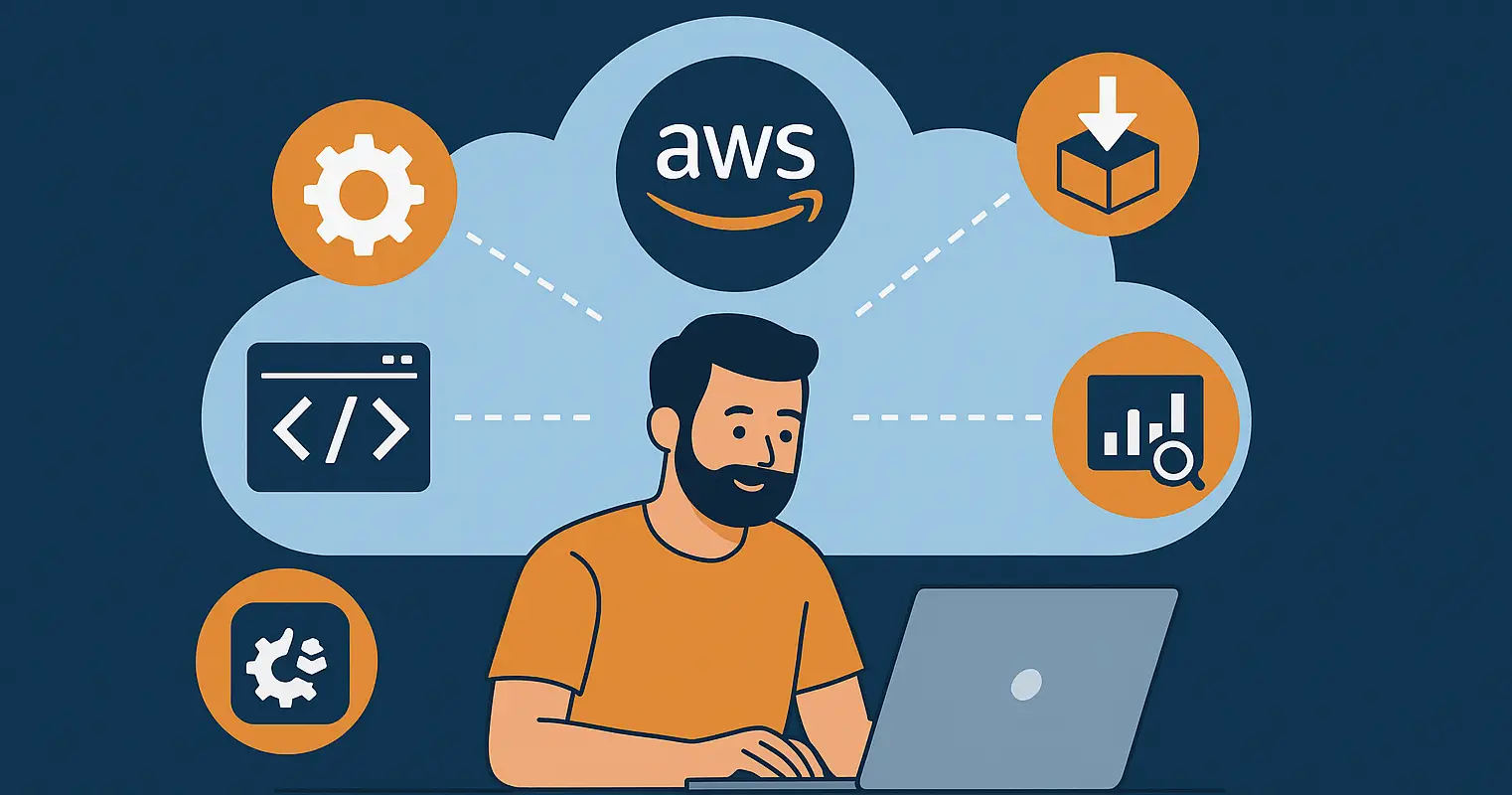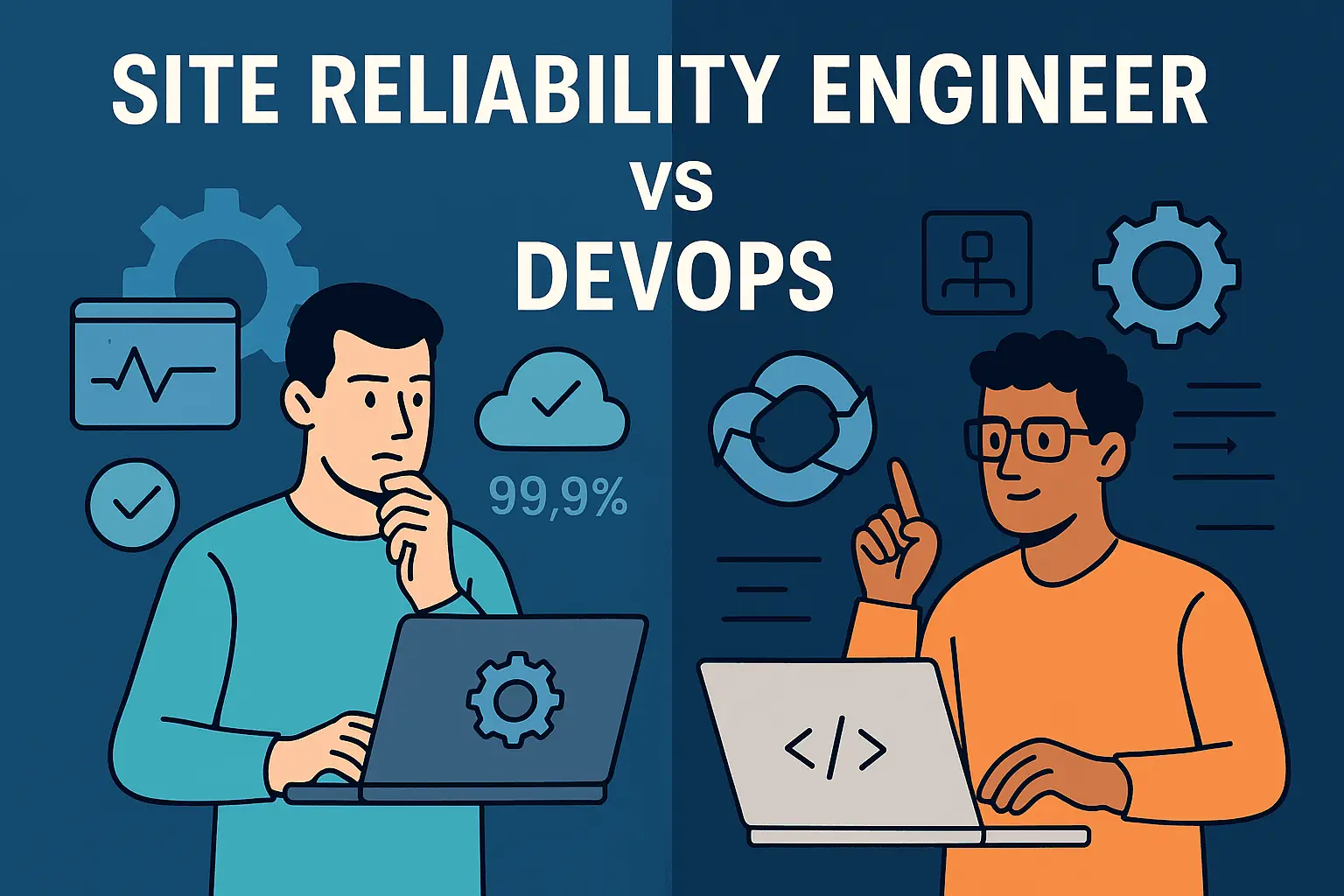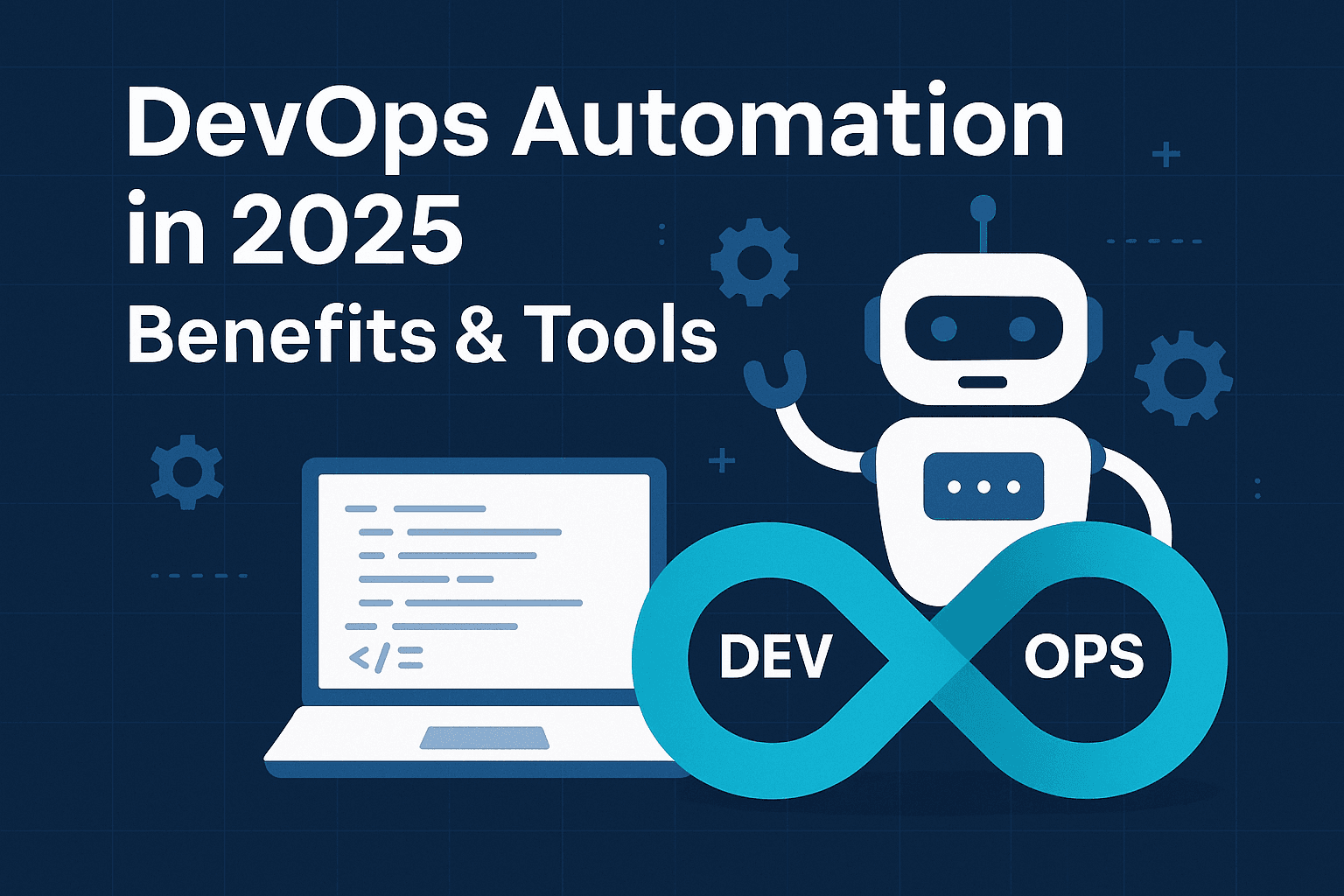So, you’ve heard this word “DevOps” buzzing around, right? Maybe someone mentioned it, or you saw it in a blog, or maybe you’re just trying to figure out why your company’s software releases feel like pulling teeth. I get it. It sounds technical, maybe even a bit intimidating. But honestly?
At its heart, DevOps is pretty straightforward, especially in 2025. Let’s break it down together, step by step.
Think of it like this: Remember those old cartoons where the design guys (Devs) would throw a finished blueprint over a wall to the operations guys (Ops), and then chaos ensued?
Yeah, that wall sucked. DevOps is basically about smashing that wall down. It’s not just a set of tools (though tools help!), and it’s not just a job title.
DevOps is a culture, a way of working, where developers (the folks who build software) and operations folks (the folks who run and keep that software alive) work together super closely throughout the entire life of an app. The goal?
To build, test, and release software faster, more reliably, and way less painfully than the old ways.
Sounds good, right? But how does it actually help with the development process in 2025? Let’s dive in.
DevOps Explained: What Is It and How Does DevOps Work in 2025?
Okay, so we smashed the wall. Cool. But what are (Devs) development and operations (Ops) doing together?
The Goal of DevOps (It’s Simple!): It boils down to two big things:
Speed: To shorten the development lifecycle. This means getting new features and fixes out to users fast.
Stability: Making sure those new things don’t break the whole system. Nobody likes a crashing app, least of all the person getting paged at 3 AM! So DevOps ensures compliance through continuous integration and continuous communication.
How the Model Supports Collaboration (No More Silos!)
Instead of Devs coding in their cave and tossing it “over the wall” for Ops to somehow deploy and keep running (often leading to finger-pointing when stuff breaks), they work as one team. They share responsibility. Devs think about how their code will run in the real world. Ops, get involved early to understand what’s coming.
They automate everything possible for quick software delivery. Imagine building a car where the engineers and the mechanics are constantly talking, testing parts together as they’re made, not just when the whole car is finished and won’t start.
DevOps vs Agile
Clearing Up the Confusion: You might have heard of Agile, too. Agile is mainly about how developers work together – in small chunks, getting feedback quickly. DevOps builds on Agile.
Think of Agile as focusing on building the right thing efficiently within the development team. DevOps takes that built thing and says, “Awesome, now let’s get it out to users safely and keep it running smoothly,” involving the Ops side heavily. Agile is about building iteratively to deliver software, whereas DevOps is about building, deploying, and operating iteratively. They’re best friends in 2025.
So, DevOps in 2025 isn’t some magical unicorn. It’s that tight teamwork and shared goal, turbocharged by really smart automation.
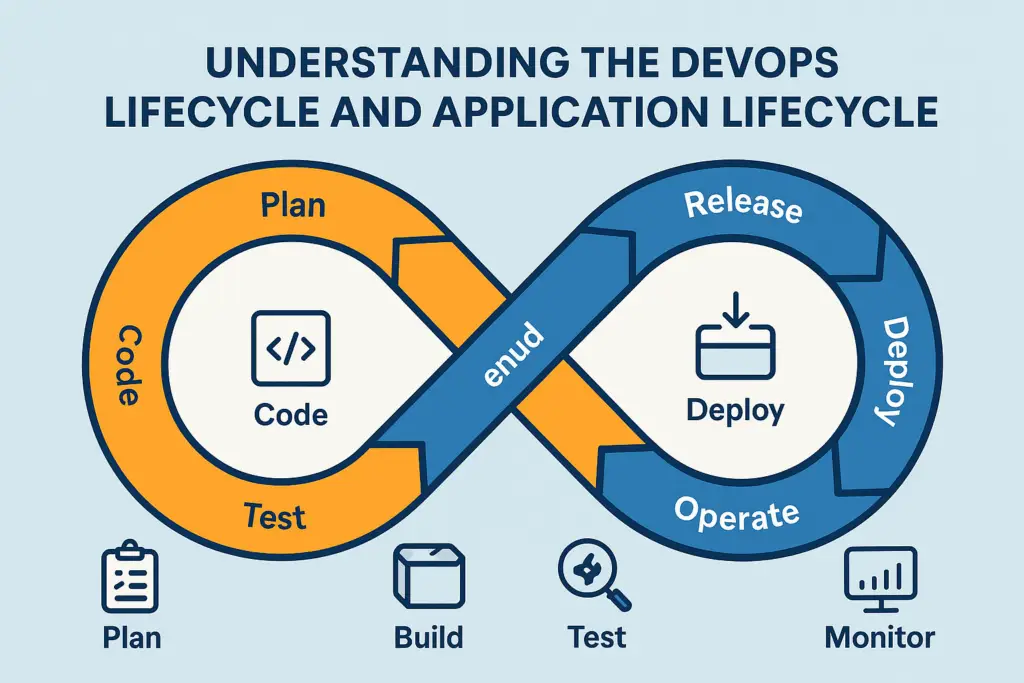
Understanding the DevOps Lifecycle and Application Lifecycle
Alright, so how does this teamwork actually flow? It happens in a loop, called the DevOps Lifecycle. Think of it as a continuous circle of improvement for your app. Here’s the breakdown (keeping it simple!):
Plan: What are we building or fixing? Everyone (Devs, Ops, maybe even security and business folks) chats and plans together. No surprises later!
Code: Developers write the code. But now, they might use shared code repositories (like GitHub) from the start, so everyone can see what’s happening.
Build: The code gets compiled into something that can actually run. This is automated.
Test: This is HUGE and continuous. Automated tests run constantly – does the code work? Is it secure? Does it break anything else? Catching bugs early is way cheaper and less stressful.
Release: Okay, it passed the tests! Now it’s ready to be packaged up for deployment. This step is also heavily automated.
Deploy: The new code gets pushed out to where users can access it (like servers or the cloud). In fancy setups, this can happen automatically after tests pass! (That’s the dream).
Operate: Ops (and now Devs helping!) monitor the app in the real world. Is it running fast? Are users happy? Any errors?
Monitor: Constantly watching performance, user feedback, logs… everything! This feeds right back into…
Plan (Again!): Based on what we learned from monitoring and operating, we plan the next improvements or fixes. The loop continues!
Benefits of DevOps for Modern Development Teams
So, why all the fuss? Why are companies jumping on DevOps? Because the perks are real, both for the business and the tech folks:
Business & Technical Perks (Win-Win!)
Faster Time-to-Market: Get new features and fixes to customers way quicker. Beat your competitors. React to feedback fast.
Improved Quality & Stability: Constant testing and smaller, more frequent changes mean fewer big, scary bugs. Happy users, happy Ops team (less 3 AM firefighting!).
Increased Efficiency: Automation! Less manual grunt work. Teams get more done with less frustration.
Better Collaboration & Morale: Breaking down silos means less blame, more shared wins. Teams actually understand each other’s challenges.
More Innovation: Freeing up time from fighting fires means more time to build awesome new things.
Cost Reduction (Long Term): Fewer failures, faster recovery when things do go wrong (they always do!), and more efficient resource use (thanks to IaC and cloud) save money.
Faster Delivery Through DevOps Practices
This isn’t just hype. CI/CD pipelines can push code live in minutes or hours, not weeks or months. Imagine fixing a critical bug and having it live for users the same day. That’s the power.
Improving Efficiency with Specific Tools
Remember those tools we talked about? Here’s how they directly boost efficiency in software development:
- CI/CD Tools: Automate builds, tests, and deployments. Saves tons of time.
- IaC (Terraform, etc.): Spin up identical dev, test, staging environments in minutes. No more waiting weeks for IT to provision a server.
- Configuration Management (Ansible, etc.): Ensure every server is set up perfectly, automatically. No configuration drift.
- Monitoring Tools: Catch problems before users do, and fix them faster. Less downtime = happier everyone.
Basically, DevOps makes building and running software smoother, faster, and less stressful for everyone involved.
DevOps Culture and the Role of DevOps Engineers
Here’s the thing: You can have all the fancy tools in the world, but you need to adopt a DevOps culture to be successful. DevOps Tools enable the culture, but they don’t create it.
How DevOps Culture Impacts Team Dynamics: It’s a mindset shift:
- Shared Ownership: Everyone owns the entire process, from the code idea to running smoothly in production.
- Collaboration & Communication: Constant talking, sharing, and helping. Daily stand-ups, chat tools, shared dashboards.
- Fail Fast, Learn Faster: Mistakes happen. Instead of blaming, focus on learning and fixing quickly. Automate recovery!
- Continuous Improvement: Always asking, “How can we make this better, faster, safer?” Experimentation is encouraged.
- Automation First: If it’s manual, repetitive, and boring, automate it!
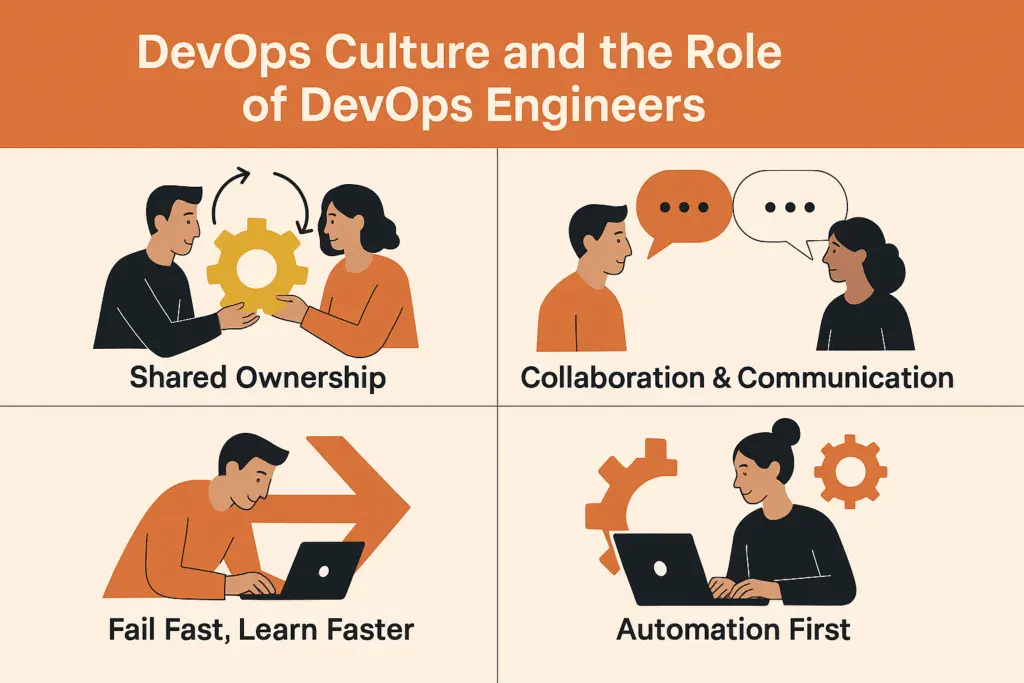
The Evolving Role of a DevOps Engineer in 2025
This role is fascinating and keeps changing. It’s NOT just a sysadmin who knows a bit of scripting anymore. Think of them as:
- Automation Ninjas: Their superpower is automating everything – builds, tests, deployments, infrastructure.
- Toolchain Wizards: They know the CI/CD, IaC, monitoring, cloud platforms inside out and choose the best tools for the job.
- Bridge Builders: They speak both “Dev” and “Ops” fluently and help the teams collaborate effectively.
- Reliability Champions: Focused on making systems resilient, observable, and easy to recover.
- Security Advocates: Security (“Sec”) is baked into the process (more on DevSecOps later!), and DevOps engineers help make that happen. In 2025, coding skills (Python, Go), deep cloud knowledge (AWS, Azure, GCP), and security awareness are absolute must-haves.
Building a Strong DevOps Team Structure
There’s no one-size-fits-all, but common models include:
- Embedded DevOps: DevOps engineers sit directly within product development teams.
- Centralized DevOps Platform Team: A dedicated team builds and maintains the shared tools and platform that all other dev teams use. They enable others.
- Hybrid Models: A bit of both – a core platform team supporting embedded engineers in product teams. The key is enabling collaboration and providing the right tools and expertise where needed.
The culture is the glue. The DevOps Engineer is the facilitator and enabler. Get these right, and the magic happens.
Outsourcing and How to Adopt DevOps in 2025
Maybe your team is small. Maybe you lack specific skills. Maybe you just need help getting started. That’s where DevOps Outsourcing comes in.
What is DevOps Outsourcing?
It means hiring an external company or experts to handle some or all of your DevOps needs. This could be:
- Setting up your initial CI/CD pipeline.
- Managing your cloud infrastructure.
- Providing 24/7 monitoring and support.
- Building your entire DevOps strategy and toolchain.
The benefits we talked about (speed, stability, cost savings) are too big to ignore. Staying with slow, manual, siloed processes puts you at a massive disadvantage. Outsourcing can be a way to kickstart your journey if internal resources are tight.
How to Get Started with DevOps Using Outsourced Services?
- Know Your Pain Points: What hurts the most? Slow releases? Constant outages? Lack of automation? Be clear on what you want to fix.
- Define Clear Goals: What does “success” look like? Faster release cycles? Fewer Sev-1 incidents? Better collaboration?
- Find the Right Partner: Look for experience, cultural fit, strong communication, and expertise in the specific tools/platforms you use (or want to use). Check references!
- Start Small (Maybe): You don’t have to boil the ocean. Maybe start by outsourcing pipeline setup for one key application, or getting help with cloud cost optimization.
- Focus on Knowledge Transfer: If you eventually want internal skills, ensure the outsourcing partner trains your team.
In-House vs Outsourced DevOps Engineers: The Trade-offs:
In-House:
- Pros: Deep understanding of your business/apps, fully integrated into the team, full control, potentially better long-term cost for core needs.
- Cons: Hard to find and hire top talent (it’s competitive!), expensive salaries/benefits, takes time to build the team.
Outsourced:
- Pros: Access to specialized expertise immediately, often faster to get started, potential cost savings (especially for specific projects or 24/7 coverage), flexibility to scale up/down.
- Cons: Less direct control, potential communication/coordination challenges, risk of “black box” if knowledge transfer isn’t prioritized, ongoing costs for services.
Outsourcing is a valid strategy in 2025, especially for bridging skill gaps or accelerating adoption. Just do it thoughtfully.
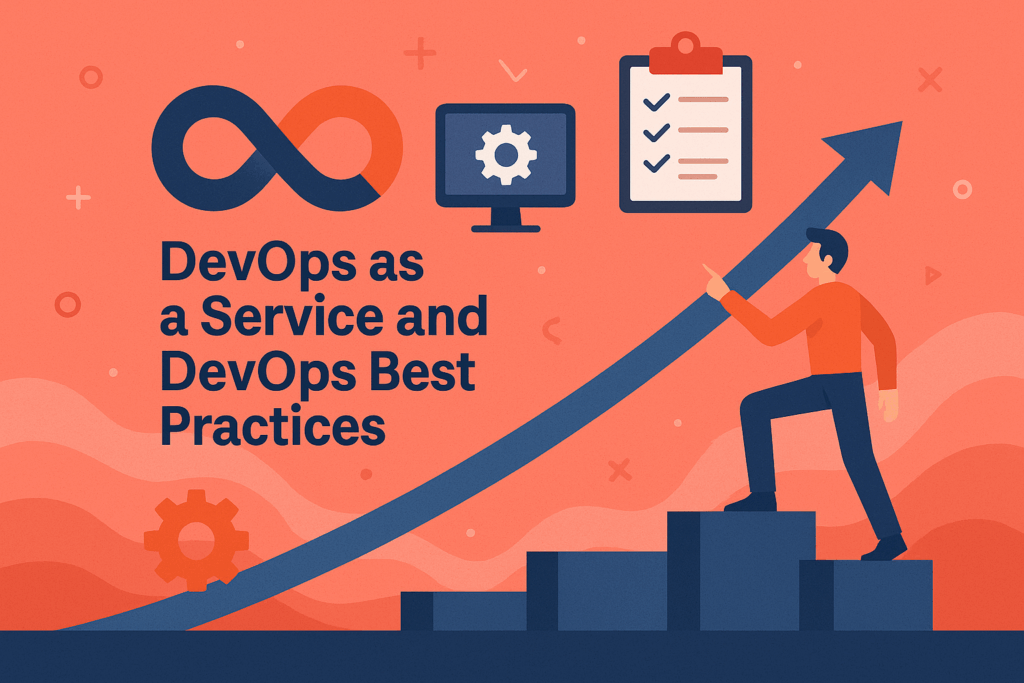
DevOps as a Service and DevOps Best Practices
You might also hear the term DevOps as a Service (DaaS). What’s that?
What is DaaS?
Think of it as the “outsourcing on steroids” model, but specifically packaged. A provider offers a comprehensive, pre-defined set of DevOps tools, processes, and expertise as a subscription service. They manage the underlying platform (tools, infrastructure) and provide the people/processes. You essentially rent a complete DevOps capability.
DevOps Best Practices for Scalability and Security (Crucial in 2025!)
Whether you do it in-house, outsource, or use DaaS, these principles are key:
Everything as Code (EaC): Infrastructure (IaC), configurations, pipelines, policies – manage it all in version-controlled code. Reproducible, auditable, scalable.
Automate Everything (Seriously): Builds, tests, deployments, security scans, infrastructure provisioning, monitoring alerts… automate relentlessly.
Continuous Monitoring & Observability: Don’t just monitor servers; monitor user experience, application performance, logs, traces. Understand why something is happening.
Shift Left Security (DevSecOps): Integrate security testing early and often into the CI/CD pipeline. Don’t wait until the end! Automated vulnerability scanning is essential.
Immutable Infrastructure: Instead of patching servers, deploy entirely new ones from your IaC templates. More reliable, easier to roll back.
Microservices Architecture (Where Appropriate): Breaking large apps into smaller, independent services makes them easier to develop, deploy, and scale using DevOps principles. (But it adds complexity too!).
Focus on Feedback Loops: Get feedback from users, monitoring, and testing fast, and act on it. Close the loop!
Implement DevOps with the Right Tools and Partners: Don’t just grab the shiniest tool. Choose tools that:
- Integrate well with each other.
- Fit your team’s skills.
- Scale with your needs.
- Support your cloud platform(s).
Have good community/enterprise support. Your partners (if outsourcing/DaaS) should help guide this selection based on your needs, not just their preferred stack.
Best practices keep your DevOps journey on track, secure, and able to grow as you do.
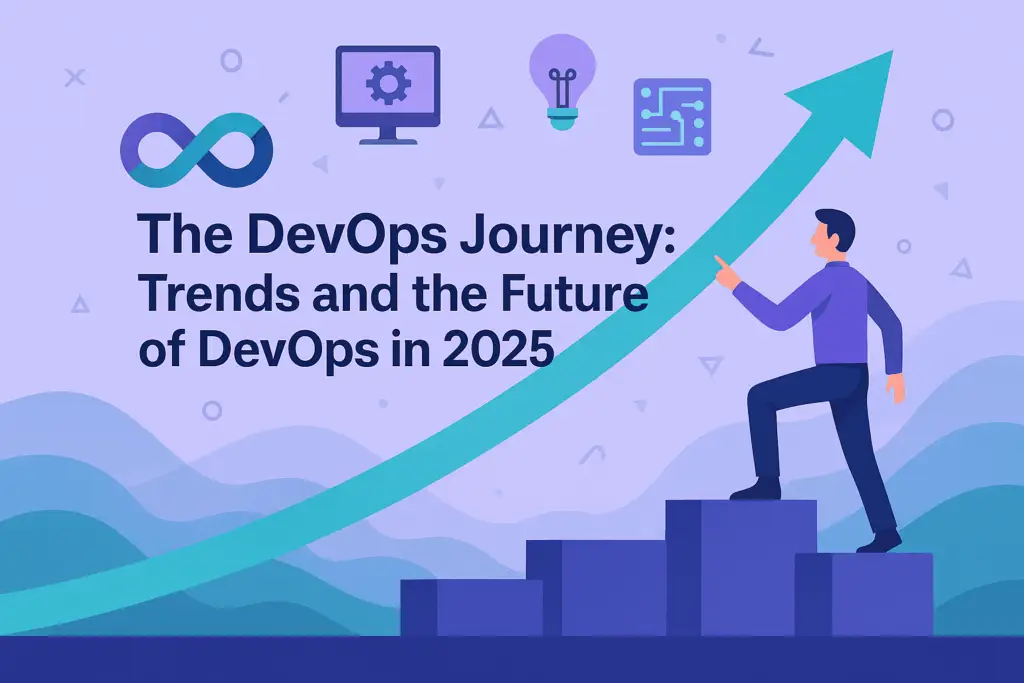
The DevOps Journey: Trends and the Future of DevOps in 2025
Adopting DevOps isn’t a weekend project. It’s a journey:
- Initial Adoption: Maybe starting with CI for one team, basic automation.
- Expansion: Spreading practices and tools to more teams, adding CD, IaC.
- Standardization: Defining consistent processes and tooling across the organization.
- Optimization: Continuously improving automation, monitoring, feedback loops. Focusing on efficiency and quality.
- Maturity: DevOps principles are deeply ingrained in the culture. High levels of automation, reliability, and speed. Security is fully integrated (DevSecOps).
So, what’s hot in DevOps for 2025?
AI and Machine Learning (ML) Everywhere: AI is supercharging DevOps:
Smarter Monitoring (AIOps): AI analyzes mountains of monitoring data to predict failures before they happen, pinpoint root causes faster, and even suggest fixes.
- Intelligent Testing: AI can generate test cases, optimize test suites, and predict which tests are most needed after a code change.
- Automated Remediation: AI systems might soon automatically apply fixes for common, known issues detected in production.
- Enhanced Security: AI analyzes code and configurations for complex vulnerabilities humans might miss.
Low-Code/No-Code for DevOps: Platforms are emerging that allow less technical team members (or even business analysts) to contribute to certain DevOps tasks, like simple workflow automation or creating basic deployment pipelines, using visual interfaces. This democratizes some aspects.
Continuous Delivery Becomes the Norm (Not Just the Goal): Truly automated, reliable, and frequent deployments to production are becoming standard for high-performing teams, not just an aspiration.
DevSecOps is Non-Negotiable: Security isn’t a separate phase; it’s woven into every stage of the DevOps lifecycle. Automated security scanning (SAST, DAST, SCA) in pipelines, infrastructure security via IaC, and security awareness for all team members are baseline requirements.
GitOps Gains Traction: Managing infrastructure and application deployments by declaring the desired state in Git repositories. Changes are made via pull requests, automatically applied. Provides strong audit trails and control.
Focus on Developer Experience (DevEx): Making the tools and processes frictionless for developers so they can focus on coding, not deployment headaches. Fast feedback loops are key here.
Sustainability in DevOps: Optimizing cloud resource usage (right-sizing, turning things off) not just for cost, but also to reduce environmental impact.
Final Thoughts: How to Successfully Adopt DevOps Tools in Your Organization
Phew, that was a lot! But hopefully, it demystified DevOps a bit. If you’re thinking about starting or improving your DevOps journey in 2025, here’s my super-simple advice:
The bottom line in 2025? DevOps isn’t a luxury; it’s how modern software gets built and run effectively. It reduces pain, speeds things up, makes systems more reliable, and ultimately lets you deliver more value to your users. It might seem daunting, but just start somewhere. Smash that wall, one brick at a time.


